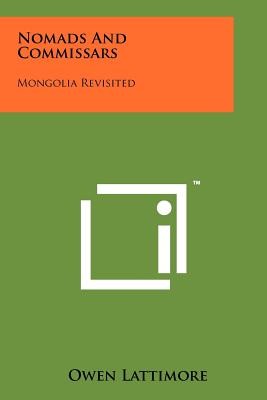
- We will send in 10–14 business days.
- Author: Owen Lattimore
- Publisher: Literary Licensing, LLC
- ISBN-10: 1258191563
- ISBN-13: 9781258191566
- Format: 15.2 x 22.9 x 1.5 cm, minkšti viršeliai
- Language: English
- SAVE -10% with code: EXTRA
Reviews
Description
Nomads and Commissars: Mongolia Revisited, which was first published in 1962, provides a lively description of modern-day Mongolia, combined with historical material.
Beginning with a geographical description, author Owen Lattimore narrates Mongolian history, both political and economic. He explains how and why Marxism succeeded in a country of nomads with almost no industry, capitalists, or middle class. His chapter on the revolution focuses on the partisan leaders, Sukebator and Choibalsang, and his account of Mongolia’s past and present relations with Russia and China is especially timely in view of the difficulties being experienced between those two countries.
The author was a well-respected scholar, fluent in both Chinese and Mongolian, and was well-underwritten by some of the most famous institutions in the world, who sponsored his research and Central Asian travels. Lattimore’s books, such as Inner Asian Frontiers of China (1940), are authoritative, fascinating and give keen insights to the complex relationships in Central Asia, the political forces, the cultural variations of the divergent peoples and the geography. His works are a valuable resource for areas largely neglected at the time mostly because the area was closed for such a long time.
Against the odds, Lattimore won his way into Mongolia and Central Asia and did his research while traveling in the most primitive areas by the traditional camel, donkey and yak cart. He talked to the people, understood their ways and culture. His record is a valuable insight into who and what transpired during the 1920s, right through to the 1940’s.
EXTRA 10 % discount with code: EXTRA
The promotion ends in 22d.00:39:02
The discount code is valid when purchasing from 10 €. Discounts do not stack.
- Author: Owen Lattimore
- Publisher: Literary Licensing, LLC
- ISBN-10: 1258191563
- ISBN-13: 9781258191566
- Format: 15.2 x 22.9 x 1.5 cm, minkšti viršeliai
- Language: English English
Nomads and Commissars: Mongolia Revisited, which was first published in 1962, provides a lively description of modern-day Mongolia, combined with historical material.
Beginning with a geographical description, author Owen Lattimore narrates Mongolian history, both political and economic. He explains how and why Marxism succeeded in a country of nomads with almost no industry, capitalists, or middle class. His chapter on the revolution focuses on the partisan leaders, Sukebator and Choibalsang, and his account of Mongolia’s past and present relations with Russia and China is especially timely in view of the difficulties being experienced between those two countries.
The author was a well-respected scholar, fluent in both Chinese and Mongolian, and was well-underwritten by some of the most famous institutions in the world, who sponsored his research and Central Asian travels. Lattimore’s books, such as Inner Asian Frontiers of China (1940), are authoritative, fascinating and give keen insights to the complex relationships in Central Asia, the political forces, the cultural variations of the divergent peoples and the geography. His works are a valuable resource for areas largely neglected at the time mostly because the area was closed for such a long time.
Against the odds, Lattimore won his way into Mongolia and Central Asia and did his research while traveling in the most primitive areas by the traditional camel, donkey and yak cart. He talked to the people, understood their ways and culture. His record is a valuable insight into who and what transpired during the 1920s, right through to the 1940’s.


Reviews